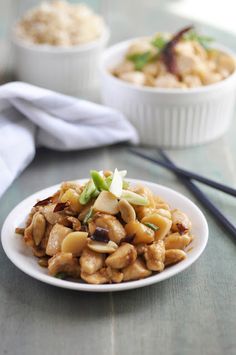Substitutes for Water Chestnuts

Water chestnuts are a dependable component with a crunchy texture and a subtle sweetness. They are a popular component, particularly in Chinese cooking.
Water chestnuts have grown in China since ancient times and are often found in Asian stores and cuisine. The name stems from the fact that they have the form and color of chestnuts.
The water chestnut is not a nut but rather a freshwater marsh plant with an aquatic tuber. Although this is not recommended, they can be eaten raw because they may carry infections from the water where they grew. But what happens if you can’t locate any? Is there anything else you might use in its place?
You certainly can. Although this component is often used in Asian cuisine, other popular ingredients like turnips, canned water chestnuts, Jerusalem artichokes, and jicama slices can be substituted.
In addition, because there is flour derived from water chestnuts, we have included various water chestnut flour replacements below. Read on to learn more about using water chestnuts in cooking and some dish ideas and alternatives.
Substitutes for Water Chestnuts
There’s no need to be concerned; water chestnuts may be substituted. Read on to learn about other options that have similar flavors to water chestnuts. They serve the same purpose and can be substituted in equal amounts or customized to taste.
1 .Turnip
This is a cheaper alternative to water chestnuts. This root vegetable, closely related to potatoes and beets, originated in eastern Asia and was widely farmed across the Roman Empire.
As an alternative for water chestnuts, slice the turnip and combine it with some oil, salt, and water. Cook, covered, until soft. This option may be added to various Eastern cuisines and served as a side dish.
They have a mildly spicy flavor, and as they age, they have a strong mustard flavor that mellows after cooking.
2. Canned water chestnuts

If freshwater chestnuts are unavailable, canned water chestnuts can be used. They taste almost identical to fresh ones, while fresh ones have a nuttier flavor. Because they are nearly identical, you can always replace one for the other.
3. Jerusalem Artichokes
The Jerusalem artichoke is another good alternative. It is a lumpy, brown-skinned tuber derived from the sunflower that looks like a ginger root. It’s white, nutty, sweet, and crunchy, and it’s high in iron. It works well in various dishes—Substitute Jerusalem artichokes for the water chestnuts.
4. Jicama Slices
This root vegetable has a papery, golden-brown exterior and a white starchy. It originated in Mexico and has since spread throughout Asia. It requires a long growing season and thrives in warmer climates. It’s pretty juicy, with a little sweet and nutty flavor that reminds me of chestnuts. Use the same quantity or adjust the amount to taste.
Water Chestnut Flour Substitutes
Water chestnut flour is prepared by grinding dried water chestnuts. Before being ground into flour, water chestnuts are cooked, peeled, and dried.
Flour is frequently used as a thickening. Water chestnut flour is also used to enrich deep-fried foods in Asian cuisine. It imparts a delicate crust to the meal and remains white even when cooked.
If you don’t have any water chestnut flour on hand, don’t panic - refer to the list of substitutions below.
5. Almond Flour
This water chestnut flour alternative is high in protein and, more crucially, gluten-free. You may prepare it yourself by grinding blanched sweet almonds, or you can buy it from a health food store. It has a less sweet flavor and is a granular texture than water chestnut flour.
6. Hazelnut Flour

This flour is created from raw hazelnuts and can be used in water chestnut flour. Hazelnut flour is a grain-free nut flour that is excellent for baking.
This gluten-free flour may also be used to bread poultry, fish or to add to smoothies. The finished dish will be a little heavier because it contains more fat than water chestnut flour.
Water Chestnut as an ingredient
Water chestnuts are commonly utilized in Chinese dishes and may be found in vegetable stir-fries and a popular bacon appetizer. They also provide a creamy spinach dip crispness and an unusual taste to vegetable side dishes. They are often added after the cooking process.
Water chestnuts are incredibly healthy, with high levels of fiber, potassium, magnesium, and copper. They also have vitamin B6 and riboflavin and get their calories from carbohydrates.
The taste of freshly plucked freshwater chestnuts differs from that of canned chestnuts. They have a fruity, nutty, and sweet flavor, similar to a mix between an apple and coconut. On the other hand, the canned ones have hardly any flavor.
Is there a difference between a chestnut and a water chestnut?
Tree chestnuts are a type of brown nut that grows from catkin blossoms. On the other hand, water chestnuts are underground stems known as corms or tubers that must be dug out to harvest. So, no, they are not the same, and their flavors differ.
How do you prepare water chestnuts?
Combine water chestnut in a small dish with two teaspoons of olive oil: one tablespoon salt and 12 teaspoons black pepper over the chestnuts. Stir in the water chestnuts until they are seasoned. Spread them out on a baking sheet and roast for 15 minutes.
Is it necessary to boil water chestnuts?
Freshwater chestnuts may be eaten raw, but they must be peeled first. Whether using fresh or canned water chestnuts, add them towards the end of the cooking time to maintain the most crunch and fit nicely in the dish.











